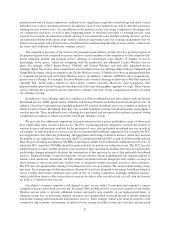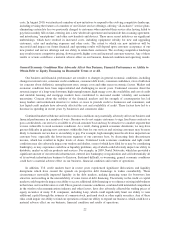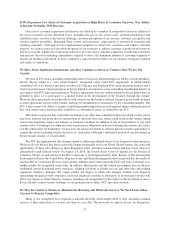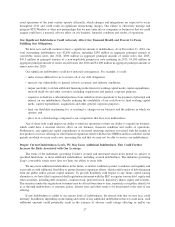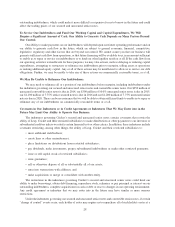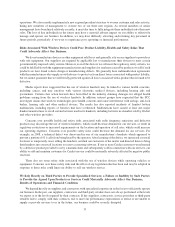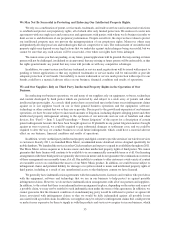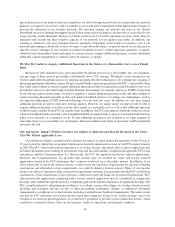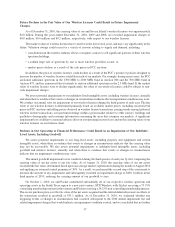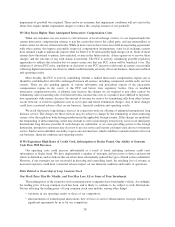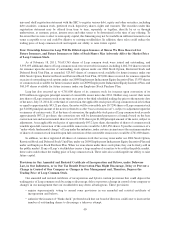Cricket Wireless 2010 Annual Report Download - page 36
Download and view the complete annual report
Please find page 36 of the 2010 Cricket Wireless annual report below. You can navigate through the pages in the report by either clicking on the pages listed below, or by using the keyword search tool below to find specific information within the annual report.A Significant Portion of Our Assets Consists of Wireless Licenses, Goodwill and Other Intangible Assets.
As of December 31, 2010, 42.69% of our assets consisted of wireless licenses, goodwill and other intangible
assets. The value of our assets will depend on market conditions, the availability of buyers and similar factors. While
the value of these assets is determined by using the market approach for purposes of our impairment testing, those
values may differ from what would ultimately be realized by us in a sales transaction and that difference may be
material. By their nature, our intangible assets may not be readily saleable or, if saleable, there may be substantial
delays in their liquidation. For example, prior FCC approval is required in order for us to sell, or for any remedies to
be exercised by our lenders with respect to, our wireless licenses, and obtaining such approval could result in
significant delays and reduce the proceeds obtained from the sale or other disposition of our wireless licenses.
The Wireless Industry Is Experiencing Rapid Technological Change, Which May Require Us to
Significantly Increase Capital Investment, and We May Lose Customers if We Fail to Keep Up with
These Changes.
The wireless communications industry continues to experience significant technological change, as evidenced
by the ongoing improvements in the capacity and quality of digital technology, the development and commercial
acceptance of wireless data and 4G services, shorter development cycles for new products and enhancements and
changes in end-user requirements and preferences. Our continued success will depend, in part, on our ability to
anticipate or adapt to technological changes and to offer, on a timely basis, services that meet customer demands.
Competitors have begun providing competing wireless telecommunications service through the use of
developing 4G technologies, such as WiMax and LTE. We currently plan to deploy next-generation LTE network
technology over the next few years, with a commercial trial market scheduled to be launched in late 2011. We cannot
predict, however, which of many possible future technologies, products or services will be important to maintain our
competitive position or what expenditures we will be required to make in order to develop and provide these
technologies, products and services. The cost of implementing or competing against future technological innovations
may be prohibitive to us, and we may lose customers if we fail to keep up with these changes. For example, we
expended a substantial amount of capital to upgrade our network with EvDO technology to offer advanced data
services. In addition, we may be required to acquire additional spectrum to deploy these new technologies, which we
cannot guarantee would be available to us at a reasonable cost, on a timely basis or at all. There are also risks that
current or future versions of the wireless technologies and evolutionary path that we have selected or may select may
not be demanded by customers or provide the advantages that we expect. If such upgrades, technologies or services do
not become commercially acceptable, our revenues and competitive position could be materially and adversely
affected. We cannot assure you that widespread demand for advanced data services will develop at a price level that
will allow us to earn a reasonable return on our investment. In addition, there are risks that other wireless carriers on
whose networks our customers roam may change their technology to other technologies that are incompatible with
ours. As a result, the ability of our customers to roam on such carriers’ wireless networks could be adversely affected.
If these risks materialize, our business, financial condition or results of operations could be materially adversely
affected. Further, we may not be able to negotiate or maintain cost-effective data roaming agreements on 4G or other
data networks, and we are not able to assure you that customer devices that operate on 4G or other data networks will
be available at costs that will make them attractive to customers.
The Loss of Key Personnel and Difficulty Attracting, Integrating and Retaining Qualified Personnel
Could Harm Our Business.
We believe our success depends heavily on the contributions of our employees and on attracting, motivating
and retaining our officers and other management and technical personnel. We do not, however, generally provide
employment contracts to our employees. If we are unable to attract and retain the qualified employees that we need,
our business may be harmed.
Our business is managed by a small number of key executive officers, including our CEO, S. Douglas
Hutcheson and our CFO, Walter Z. Berger. In addition, we recently hired new members of senior management to
help support our corporate and field operations, which included the appointment of Raymond J. Roman as our
executive vice president and chief operating officer and Robert A. Young as our executive vice president, field
30



